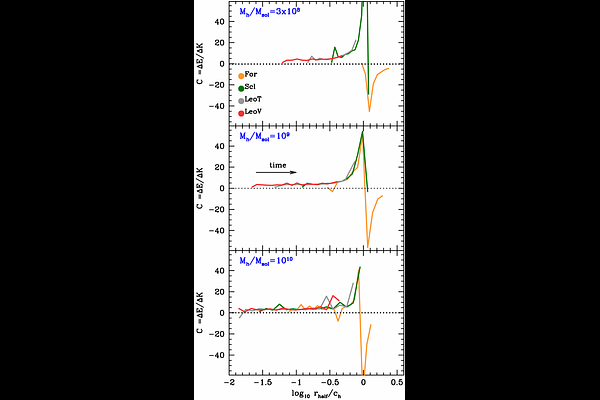Gravothermal expansion of dwarf spheroidal galaxies heated by dark subhaloes

Gravothermal expansion of dwarf spheroidal galaxies heated by dark subhaloes
Jorge Peñarrubia, Raphaël Errani, Eduardo Vitral, Matthew G. Walker
AbstractWe use analytical and $N$-body methods to study the evolution of dwarf spheroidal galaxies (dSphs) embedded in dark matter (DM) haloes that host a sizeable subhalo population. Dark subhaloes generate a fluctuating gravitational field that injects energy into stellar orbits, driving a gradual expansion of dSphs. Despite the overall expansion, the stellar density profile preserves its initial shape, suggesting that the evolution proceeds in a self-similar manner. Meanwhile, the velocity dispersion profile, initially flat, evolves as the galaxy expands: the inner regions heat up, while the outer regions cool down. Kinematically, this resembles gravothermal collapse but with an inverted evolution, instead of collapsing the stellar system expands within a fluctuating halo potential. As the half-light radius $r_{\rm half}$ approaches the halo peak velocity radius $r_{\rm max}$, the expansion slows, and the velocity dispersion peaks at $\sigma_{\rm max} \simeq 0.27 v_{\rm max}$. The stellar heat capacity remains positive for deeply embedded stars but diverges near $r_{\rm max}$, turning negative beyond this threshold, which indicates a phase transition in the dynamical response to energy injection. The relaxation time scales as $t_{\rm rel} \sim r_{\rm half}^{3/2}$, showing that orbital diffusion slows as the galaxy expands. Ultra-faint dSphs, having the smallest sizes and shortest relaxation times, are particularly sensitive to the presence of dark subhaloes. Some of our dSph models expand beyond the detection of current photometric surveys, becoming `stealth' galaxies with half-light radii and velocity dispersions similar to ultra-diffuse galaxies (UDGs), but orders of magnitude lower luminosities, representing a distinct, yet currently undetected, population of DM-dominated satellites.